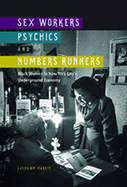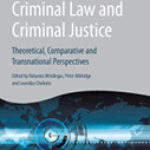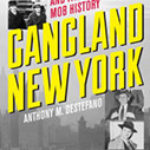Sex Workers, Psychics, And Numbers Runners: Black Women In New York City’s Underground Economy

Author: LaShawn Harris
Publisher: Urbana-Champaign, IL: University of Illinois Press, 2016. 280p.
Reviewer: Kyria Brown | March 2017
Historian and African American Studies scholar LaShawn Harris’ detailed examination of Black women in the underground economy in New York City during the first three decades of the twentieth century is a masterful compilation of criminal justice system records, archival newspaper accounts, and period-specific literature. Harris draws upon this rich and diverse set of historical data as she adroitly weaves experiences of well-known African American female informal economy workers from this time period in with police and prison records and neighborhood reactions gathered from newspaper and reform activists’ accounts and literature. The book comprises an introduction, five content chapters, and a conclusion, as well as a lengthy notes sections, brimming with references for the data gathered. Harris also skillfully includes a handful of present-time examples of African American women in the similar occupations to illustrate the cultural and systemic factors that position urban African American women into low-paying work, and that have not changed significantly over time.
Chapter One, “Black Women, Urban Labor, and New York’s Informal Economy,” sets the scene for the Black women working in the informal economy in New York City at the turn-of-the-twentieth-century. This chapter outlines the unique intersections of race and gender in New York City when the ideal of the “American Dream” was particularly prevalent. Harris illustrates how the majority of Black women in New York were forced to survive in a low socioeconomic status, confined by their race, their often immigrant status, their gender, and the physical and mental effects such constraints predicated. Harris says that these women embraced the informal economy as a way to obtain financial security, fulfill desired lifestyles, and reshape the common narratives of Black respectability. Chapters two, three, and four then build upon this backdrop by delving into a case study of well-known informal economy workers in each category, while chapter five explores the community reaction to the informal economy in a wonderfully in-depth manner.
Chapter Two, “Madame Queen of Policy: Stephanie St. Clair, Harlem’s Numbers Racket, and Community Advocacy,” describes the Harlem informal lottery network, and in particular one of the most successful female policy bankers, Stephanie St. Clair. While St. Clair was regarded as New York’s “Number Queen,” most Black women interested in the numbers game and the evasive fortune it promised found comfortable roles as policy slip runners. Given its widespread acceptance in Harlem, the numbers game offered informal economy work for Black women with relatively little intracommunity social risk — excepting from the police and the criminal justice system. Historical accounts in this chapter tell of how Stephanie St. Clair, an immigrant mob boss, held her position of power in the numbers racket as she displayed her wealth and social mobility, and even challenged the New York police by campaigning against police corruption and giving a portion of her fortune to bettering the Black community. The author also systematically and comprehensively examines the wide-spread violence against African American people and culture, even in the North, during the time of Jim Crow – one of the inspirations for St. Clair’s campaign against the NYPD and for community advocacy.
Chapter Three, “Black Women Supernatural Consultants, Numbers Gambling, and Public Outcries against Supernaturalism,” explores how some women built upon powerful cultural tradition as their method of working in the informal economy. Harris opens this chapter with one of her well-placed modern-time vignettes concerning Black women continuing the job-types examined in the book — in this case the 1990’s television physic Miss Cleo. She then describes the fusion of “African rituals, traditions, and worldviews with that of Anglo-American religion” (p. 95) as the foundation for “supernatural labor” in the informal economy. Focusing on one of the most famous supernatural laborers, Madame Fu Futtam, whose books are still in circulation today, Harris illustrates the pull of the supernatural on the African American community, as a beacon of hope against poverty, illness, and violence. The clientele of the supernatural laborers were keen to gain monetary wealth by having their numbers influenced by dream interpretations, their illnesses healed by herbal concoctions and spells, and all else in their lives set neatly into place by following the advice of their preferred supernatural worker. As Harris does in every chapter, the opposing forces and disapproving actors are well-explained here. In the case of supernatural laborers, the practice of claiming respectable titles such as doctor or professor, and the holding of degrees from occult schools, were quickly undermined by New York’s medical-centric policies and city-wide campaigns against supernaturalism, that inspired violence against those who professed to hold supernatural gifts. Harris illustrates, however, that the organization against supernatural labor did not completely succeed in squelching its existence as, similarly with the other popular aspects of the informal economy, it is alive and well today in varied forms.
Chapter Four, “’I Have My Own Room on 139th Street’: Black Women and the Urban Sex Economy,” explores the complex sex industry in New York, along with its economic benefits and the danger present due to the over-sexualization and dehumanization of Black women that is created by systemic racism. Black women’s participation in the sex industry served as an easily accessible and lucrative occupation, and allowed women to express their sexuality. As outlined by Harris, sex work seems to be the most contested and frowned-upon venue of work in the informal economy, and in the neighborhoods where it took place; this despite a level of acceptance in the popular culture of the time. The chapter details the various aspects of sex work in New York, including avoiding anti-vice police, working indoors versus outdoors, selecting patrons, and dealing with violence. The author also details the anti-prostitution actors who included the police and so-called “social reform investigative organizations” (p. 126), who were responsible for monitoring and lobbying against prostitution. Harris presents the issue of sex work, however divisive, as a diverse one, touching on the prevalence of false accusations and “badgers,” or women who would promise sex and instead rob their client with or without providing sex.
Chapter Five, “‘Decent and God-Fearing Men and Women’ Are Restricted to These Districts”: Community Activism against Urban Vice and Informal Labor,” returns, in a way, and expands on the background information presented in chapter one. Rampant racism occurred in the form of housing discrimination and violence against any African American who attempted to live outside of Black neighborhoods. This necessitated that Black people of all classes, beliefs, and occupations live in close proximity. Harris has found ample evidence that suggests that the extralegal work of the informal economy was less than welcome by the formal economy workers in Black neighborhoods. The disapproval described in this chapter was heavily focused on the sex industry, including many instances of neighbor complaints against sex workers and brothel owners. The chapter also outlines the community activism and improvement initiatives that attempted to combat the institutional racism, as well as some improvement initiatives that openly ignored Black communities.
This book has numerous strengths that derive, first and foremost, from the author’s painstakingly gathered sources, and her astute ability to combine these sources into well-argued assessments. Harris does not shy away from a very honest discussion about racism and racial constraints, or from the social constraints that stemmed from the respectability politics promoted to combat racism during this time period. It is easy to overlook or to ignore the systemic racism in turn-of-the-twentieth-century New York, because of its technical and geographical separation from the Jim Crow South, but as Harris explains, racism was equally pervasive and harmful and surprised many when they came to New York hoping for all that the city had to offer. Overall, this book is a masterful gathering of a myriad of sources, and shows the connections to the modern-day informal economy as navigated by today’s Black women.
As with any scholarly work, some weaknesses may be perceived. Beginning in the introduction, Harris seems to construct a hierarchy of jobs in the informal economy, with sex work near the bottom. Some readers may be troubled by the disapproving and at times simplistic tone used to speak of sex work and the women who choose it, thus missing an opportunity to delve deeper into a complex occupation. This book, or rather the future work that it will inspire, would also have benefited from a more detailed explanation of methods. Notwithstanding these minor shortcomings, the overall analysis and compilation of innumerable historical sources is nothing less than extraordinary.
Sex Workers, Psychics, and Numbers Runners: Black Women in New York City’s Underground Economy will be of great interest to historians, African American and Diaspora Studies scholars, and will hold the rapt attention of students in both disciplines. It will be a welcome addition to the literature and could be successfully employed in any course that examines gender, race, and history. Taken as a whole, the book is a comprehensive and highly impressive analytical account of a diverse set of Black women, and should be regarded as one of the foremost additions to the literature in its fields.
Kyria Brown, University of Wyoming


